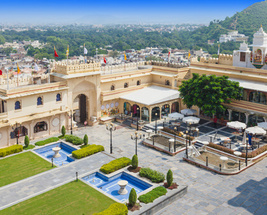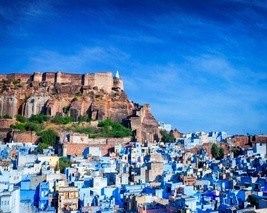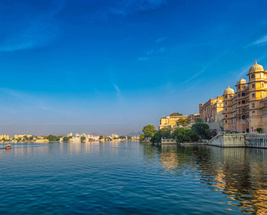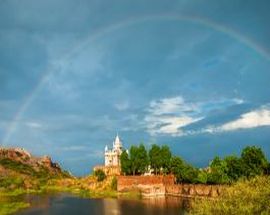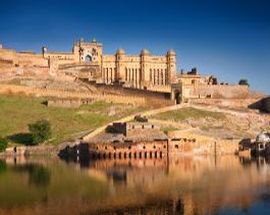Jodhpur - A symphony of Blue
Tie and dye turbans. Rajasthani textiles. Marwari horses. A trail of Jodhpur’s culture. Towering forts. Magnificent palaces. Box-blue homes. A reflection of its nuanced architecture. Golden spices. Medieval streets. Bustling Bazaars. An embodiment of its vivacious day to day life Gardens. Lakes. Desert land. Proof of its varied topography. Jodhpur tourism is a gift wrapped in all things good.
| Jodhpur Tourism: A Quick View of the state |
| State |
Rajasthan |
| Official Language |
Hindi |
| Dial Code |
02931 |
| Population |
1.8056 million (as of 2018) |
| Currency |
Indian Rupee (INR) |
| Time Zone |
UTC+05:30 (IST) |
| Area |
22,850 square kilometers |
Highlights of Jodhpur: Sights and Spice
History
One of the largest forts in India, Mehrangarh Fort wears power and confidence like a fine robe. The impressive façade is situated atop a hill, spearing 410 metres into the air. Exuding the chiselled and rugged craftsmanship of the Rathores. Mehrangarh consists of exquisite palaces, airy courtyards and one of Rajasthan’s most well stocked museums. You must check out Moti Mahal, a palatial room within the fort. Its stain glass windows dazzle as warm sunshine pours in. The ceiling is speckled with gold leaves, seashells and mirrors. But perhaps the most beguiling of them all is Phool Mahal. Built as a pleasure room for the Maharajas, the space resembles a beautiful blooming flower. Gold filigree work adorns the walls, accompanied by priceless paintings and portraits. And the best part is, you can go zip lining on the north side of the fort! Tourism in Jodhpur would be amiss without a trip to this magnificent place. Other heritage wonders include – Khejarla Fort, Umaid Bhawan Palace, Samand Palace, Jaswant Thada and Ghanta Ghar. Each monument is unique in design, each narrates a different story.
Nature
Mandore Gardens runs along a sprawling and vast piece of land. You will discover cenotaphs of powerful Jodhpur rulers, standing tall and proud. Dating back to the 17th century, these red sandstone structures are laden with intricate pillars, spires and carvings. Verdant lawns surround these monuments, whispering secrets from a bygone era. You can explore this ancient garden and marvel at the architecture. Another special place to visit is Rao Jodha Desert Rock Park. 72 hectares of lush park is filled with delightful native species that have been planted and restored. The aim is to promote the biodiversity of the region. There are winding walking trails leading to beautiful little spots such as Devkund lake, where you can glimpse butterflies, migratory birds and reptiles. Explore Jodhpur through the eyes of nature in yet another wonderful park. Chokelao Bagh captures the changing colours of the seasons, as emulated in its magical flower beds. It is a rare sight to behold under the moonlight!
Spirituality
Udai Mandir is a Hindu pilgrimage site, renowned for its exemplary architecture. Upon entering the complex, an exceptionally carved sandstone gate will beckon you to step further. The inside of the heritage temple consists of paintings depicting 84 Yogasanas and meditation poses. Gaze at the skilful work of ancient artisans. Another significant religious attraction is Baba Ram Dev Mandir. It is dedicated to deity – Ramdeoji, who is believed to be the reincarnation of Lord Shiva. The holy shrine is the resting place of the revered God. Two imposing elephant statues on either side of the entrance add to the religious ambience of the space. Once you permeate the spiritual veil, you will yearn for more. Other auspicious temples in Jodhpur include – Ganesh Mandir, Chamunda Mata Mandir and Santoshi Mata Mandir. So, take a break from Jodhpur famous places and reach into your soul.
Culture
Jodhpur’s culture is a heady blend of delicious cuisine, colourful costume, gorgeous architecture and expressive performing arts. Each tradition has been passed on for generations… It is highly influenced by the fascinating cities of Bikaner, Jalore, Pali and Nagaur. Which is not surprising, considering how they were once the collective region of Marwar. Here are some of the best places to visit in Jodhpur for an authentic cultural tour. Head over to Clock Tower Market for its rich spices, Nai Sarak for its vibrant tie and dye fabrics, Mochi Bazaar for its exquisite juttis and Tripolia Bazaar for its quintessential Rajasthani textiles. When it comes to the hot and sumptuous food, here are our favourites. Indique is a lovely candlelit restaurant at Pal Haveli Hotel that offers stunning views of the city. Try the Laal Maas, a classic Rajasthani mutton curry. To satisfy that sweet tooth in you, hop over to Janta Sweet Home and try some Jodhpuri delicacies such as mawa ladoo and mawa kachori!
Interesting facts about Jodhpur: Unboxing stories
- Jodhpur is referred to as ‘Blue city’, ‘Sun city’ and ‘Gateway to the Thar’.
- Other than Jodhpur tourism, the district is rich in non-metallic minerals that have played a very intrinsic role in its economy.
- Legend has it that a man named Raja Ram Meghwal was buried in the foundations of Mehrangarh Fort. He sacrificed himself so that the site remains auspicious.
- Legend has it that a hermit named Cheeria Nathji cursed the entire kingdom with water scarcity. Hence, every 4 years the region around Jodhpur faces drought.
Location: Desert Rose
Among the largest districts in the state of Rajasthan, Jodhpur is situated in the western region of this abundant landscape. It stands poised at 250-300 metres above sea level, encompassing areas of the arid Thar desert. The district is flanked by Nagaur in the east, Jaisalmer in the west, Bikaner in the north and Barmer and Pali in the south. An assemblage of rich cultures permeating its boundary. Nourished by the Luni River and Mithri River respectively.
Timings: Best time to visit
Owing to its geography, summers in Jodhpur are hot and dry. Temperatures fall between 32 and 43 degrees, the only relief coming during the evenings. As such, it is advisable to avoid this time of year. Monsoons are a pleasant time to visit as temperatures fluctuate between 23 and 37 degrees. The pitter patter creates beautiful patterns and symphonies in the landscape. Furthermore, it is a break from peak tourist season. When it comes to the best time to visit, winters take highest precedence because of the lovely climate. The 7 to 25-degree range makes it the perfect time to go camping in the desert or to enjoy a plethora of festivals.
How to get to Jodhpur: Fuel your travels
By Road – With an intricate network of national and state highways, one can access easily access Jodhpur. Cities such as Delhi, Ahmedabad, Jaipur and Udaipur, are especially well connected. You can hire a taxi or private vehicle and enjoy the scenic drive through quaint towns and hamlets. Should you choose to go by bus, you can avail of Volvos and deluxe coaches that regularly ply between Delhi and Jodhpur. Or, you can board a bus to Jaipur and hop onto a government bus from there.
By Rail – The railhead at Jodhpur is bound to major cities such as Mumbai, Delhi, Chennai and Kolkata. Other than being a quick and convenient method of travel, the railway offers some other unique options. You can embark on a luxurious journey via the Palace on Wheels and revel in royalty.
By Air – 5 km from the city centre is Jodhpur’s very own domestic airport. You can avail of flights, from all the major cities in India. Upon arrival, you may choose between taxis and autos to take you to your place of accommodation. The nearest international airport is IGI airport, in New Delhi, which is connected to leading destinations of the world.
History: Royal Rulers
Jodhpur’s history can be traced back to the powerful Rathore clan. The chief, Rao Jodha, has been credited with the discovery of this bountiful district in India. It was in 1459 that he discovered Jodhpur, formerly known as Marwar. After the long and illustrious reign of the Rathore rulers, fate changed drastically. In the year 1581, the region was annexed by Mughal Emperor Akbar. This was eventually followed by Aurangzeb exercising control in 1679. When the British ceased ownership, the merchants flourished and achieved dominance in trade. It was finally in 1947, post-independence, that Jodhpur was incorporated into the Union of India and deemed the 2nd largest city in Rajasthan.









